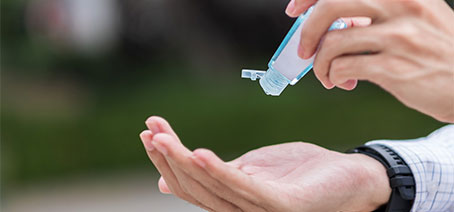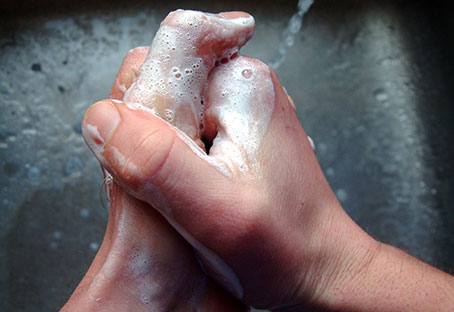Understanding our NEW daily vocabulary related to the pandemic
A lot has changed and continues to change throughout our day-to-day personal and business lives. And, that’s putting it loosely. Among the changes is a new vocabulary. Technical and medical terms that we used to use peripherally are used daily.
FUCHS helps crack the code for some of these words being more commonly used.

Bacteria and Viruses:
Bacteria are microscopic living organisms, capable of living and multiplying whenever present in an environment favorable to their growth. Most are innocuous, some are beneficial – such as digestive tract bacteria, and a few cause disease – such as Salmonella. Although viruses are also microscopic, they are not living organisms since they cannot grow or multiply unless they have infected a host cell – such as lung tissue for respiratory viruses. Since they aren’t alive, we can’t depend on “anti-bacterial” materials to eliminate their existence. Some anti-bacterials do and some don’t eliminate viruses. More on that soon.
Sanitizers and Disinfectants:
Although we tend to think these mean more or less the same thing, they have very distinct technical and legal meanings. In the US, a “sanitizer” is a material that destroys 99.999% of bacteria in 30 seconds per the ‘Official Detergent Sanitizer Test’ published by the EPA. Hand sanitizers are regulated by the Food and Drug Administration (FDA). Sanitizing kills most, but not necessarily all bacteria. They are intended mainly for use in areas that may be in contact with food. Note: “Sanitizers” do not necessarily destroy viruses. However, the EPA has determined that sanitizers that contain more than 60% alcohol are effective against the novel Corona Virus correctly known as SARS-CoV-2. Also note: COVID-19 is not the virus. It is the disease it causes.
Disinfectants are different in that they destroy all organisms in 10 minutes according to the AOAC Use Dilution Test. They are regulated as pesticides under EPA jurisdiction. Disinfectants are designed for use where complete effectiveness is more important than the speed of a clean-up job, such as hospitals. The 10 minute test period is significant to those of us using disinfectants at home and work. Most of these materials require a certain exposure time on a surface to reach maximum efficacy. When we spray a disinfectant, we often wipe it up immediately rather than leave it on the surface to achieve full effectiveness. We need to read the label to understand how it works. O n the other hand, when we use disinfectant wipes we tend not to wipe it off immediately. The solution in the wipe may remain longer on the surface. For this reason, wipes may be preferable to spray bottles.
Eliminating Novel Corona Virus:
A little further explanation on virus structure will help us understand the means of elimination. Our new viral foe has an outer protective surface containing fatty material and is susceptible to agents that break up other fatty materials like soap, many detergents, and alcohol. In short, its fatty surface is the weak link in its structure and it’s relatively easy to deactivate. Other viruses have a hard and highly protective protein shell. Norovirus, the virus we have heard about on cruise ships in the past (there’s another recent change) is in this category and is much more difficult to destroy.
The EPA has a means of giving ‘approval’ to disinfectants against new viral agents, even when the virus is so new that the appropriate science does not yet exist. At the risk of over-simplifying the process, EPA says that if a disinfectant has demonstrated to be effective and has been approved in the past for a virus that is more difficult to destroy than the new one, they will consider approving the disinfectant against the new virus. And this novel corona virus is no exception. These materials are listed by EPA under the engaging title: ‘List N: Products with Emerging Viral Pathogens AND Human Coronavirus claims for use against SARS-CoV-2’. You can find them here: https://www.epa.gov/pesticide-registration/list-n-disinfectants-use-against-sars-cov-2.
Interestingly enough, while the EPA allows manufacturers of these products to claim their efficacy against the new virus online, they do not permit it on product labels. The rationale is that as the science around the efficacy of any particular disinfectant is further developed, the supplier may need to rapidly update their published information.
What About FUCHS Cleaners?:
FUCHS RENOCLEAN products are designed for industrial use. Many products are intended for general shop use and floor cleaning. For purposes of maintaining a clean shop and proper work environment, they are very effective. They are designed to remove the oils, fats, esters and other constituents of industrial fluids similar to how hand soaps perform this function on skin. They are not, however, registered for use as sanitizers or disinfectants. We claim no effectiveness against corona virus.
A Note On Soap:
The CDC recommends regular hand washing with soap and water as the best means to keep hands clean. Not anti-bacterial soap, just regular old soap. Not hand sanitizer becasue it’s recommended as an alternative when soap and water are not readily available.
Why? We’ve already touched on some of the reasons. First soap and water readily remove dirt and other contaminants from skin allowing them to wash harmlessly down the drain. Soap is amphoteric, meaning part of the molecule is attracted to water, and another part is attracted to oil or fat. Part of the soap molecule is attracted to fatty material in the viral membrane, while the water attracting end hitches a ride down the drain with running water. But that’s not all. With proper washing including reciting your college fight song, counting to 20, and all – soap can disrupt the viral membrane, thereby rendering it inactive. While sanitizers with over 60% alcohol content work in a similar way, if hands are sweaty or wet when the sanitizer is applied, it can be diluted and rendered as ineffective. And there’s no running water to help clean areas that are missed with sanitizer. More on hand-washing from CDC: https://www.cdc.gov/handwashing/when-how-handwashing.html.
So, after reading all of this, how many of us would have thought we’d be interested in these topics just a few short weeks ago?
Let’s do what we can to stay safe and CLEAN.

Subscribe to our blog
All Blog Posts
- ECOCOOL for Aerospace
- Why is it important to use the right oil for your engine?
- TITAN CARGO - A new engine oil for new requirements
- Lubricating grease and its dropping point
- Lubricants & Technology – SOLCENIC Success
- What you need to know about Food Safety Modernization Act (FSMA) and Lubrication
- Part 2 - How to keep your parts in good condition with In-Process Corrosion Protection
- How to keep your parts in good condition with In-Process Corrosion Protection
- Four rules of thumb in lubrication – your shortcut to savings!
- A gaze into the world of cutting fluids
- When lubricants ‘get chatty’
- Did you know…? About hydraulic fluids
- Did you know…? About vehicle lubrication
- The rapidly evolving automotive industry
- Higher productivity and profitability in four stages
- Ten tips that deliver big time
